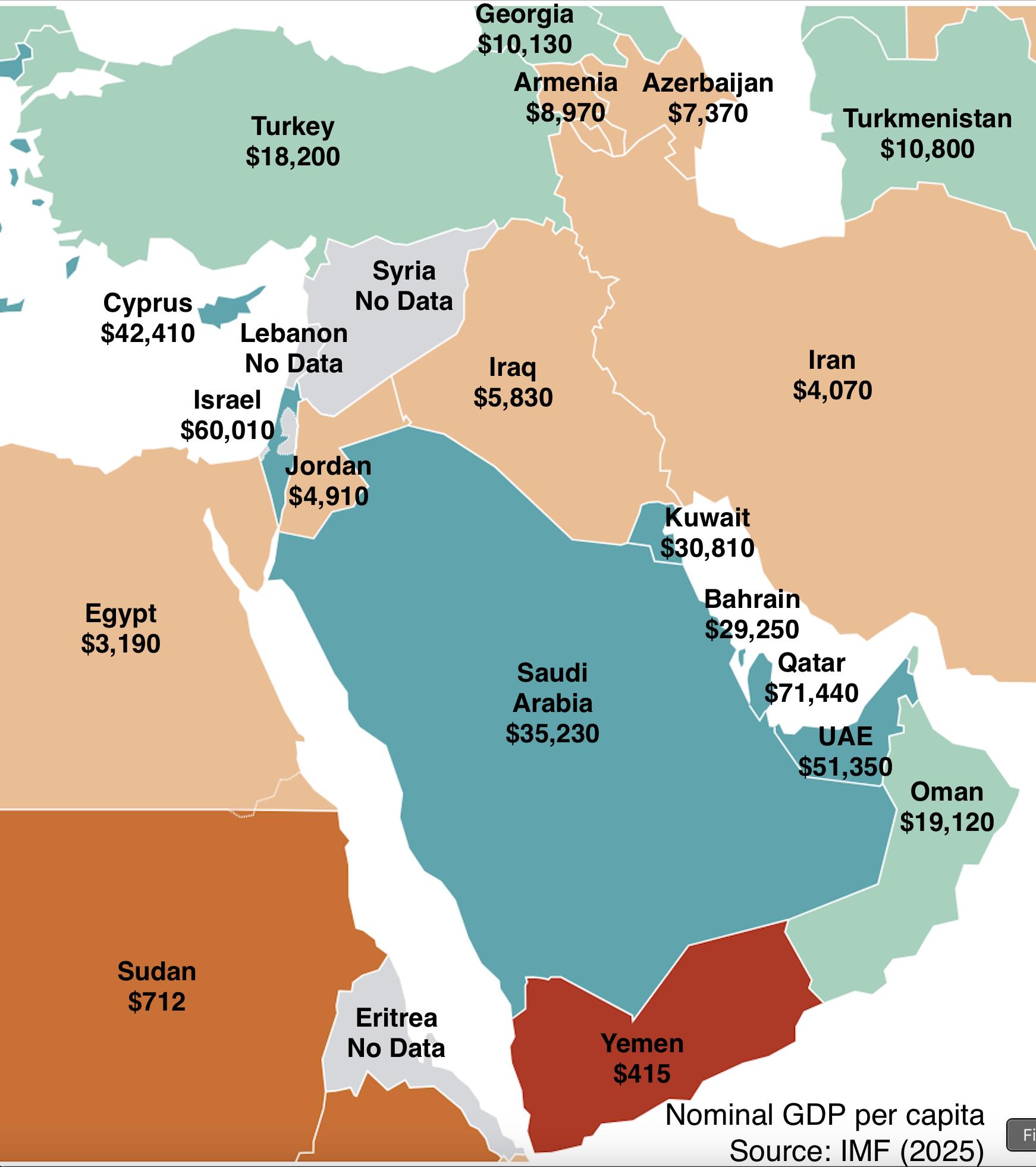GDP Per Capita by Country Map Middle East


Alex Cartwright
Senior Cartographer & GIS Specialist
Alex Cartwright is a renowned cartographer and geographic information systems specialist with over 15 years of experience in spatial analysis and data...
Geographic Analysis
What This Map Shows
The "Nominal GDP Per Capita across Middle East (IMF 2025)" map visualizes the economic landscape of the Middle East by presenting the nominal GDP per capita for each country in the region as projected by the International Monetary Fund (IMF) for the year 2025. This visualization offers a clear representation of economic disparities and wealth distribution across different nations, enabling viewers to understand how individual countries are performing economically in relation to one another.
Deep Dive into Nominal GDP Per Capita
Nominal GDP per capita is a crucial economic indicator that reflects the average economic output per person in a specific country, calculated without adjusting for inflation. It provides insights into the living standards and economic health of a nation. Interestingly, the GDP per capita can vary significantly across the Middle East, a region rich in natural resources such as oil and gas, but also featuring a diverse range of economies.
For instance, countries like Qatar and Kuwait often top the charts, with GDP per capita figures soaring above $60,000, primarily due to their abundant oil reserves and small populations. Conversely, nations such as Yemen and Syria exhibit much lower GDP per capita figures, often below $2,000, largely due to ongoing conflicts, political instability, and limited economic diversification.
What's fascinating is that GDP per capita is not just a reflection of wealth but also of how resources are managed and how inclusive a country's economic policies are. For example, UAE’s impressive GDP per capita can be attributed to its strategic investments in tourism, finance, and technology, diversifying its economy away from oil dependency. In contrast, countries that rely heavily on a single commodity often face challenges when global prices fluctuate, leading to economic vulnerability.
Additionally, the impact of population on GDP per capita cannot be overlooked. Countries with smaller populations may show higher GDP per capita figures, as the wealth generated is divided among fewer individuals. In contrast, nations with larger populations may have lower GDP per capita despite having higher total GDP figures. This highlights the importance of understanding not just the numbers, but also the context behind them.
Regional Analysis
Examining the map, we can categorize the Middle East into distinct economic regions:
1. **Gulf Cooperation Council (GCC) States**: This group, including Qatar, UAE, Kuwait, and Saudi Arabia, showcases the highest GDP per capita levels. Qatar, for instance, has invested heavily in infrastructure and education, contributing to its high economic output per person. The UAE has diversified its economy successfully, making it a regional hub for trade and tourism.
2. **Levant Countries**: This includes nations like Jordan, Lebanon, and Palestine. While Jordan has a relatively higher GDP per capita compared to its neighbors, it still faces economic challenges due to limited natural resources and regional instability. Lebanon, with its complex economic landscape, has seen fluctuations in GDP per capita influenced by political crises and economic mismanagement.
3. **Conflict-Affected States**: Yemen and Syria stand out with significantly lower GDP per capita figures. The ongoing conflicts in these countries have devastated their economies, leading to a humanitarian crisis and an inability to capitalize on any natural resources they may possess. Rebuilding these economies will require substantial international aid and political stability.
4. **Other Emerging Economies**: Countries like Iraq and Egypt have diverse economies but still face significant challenges. Iraq's GDP per capita is heavily influenced by oil revenues, while Egypt’s larger population dilutes its GDP per capita despite a growing economy. Their future economic trajectories depend on political stability and effective governance.
Significance and Impact
Understanding GDP per capita in the Middle East is crucial not only for economic analysts but also for policymakers and investors. High GDP per capita can indicate a robust economy, but it’s essential to look at the distribution of wealth within the country to truly gauge the standard of living for the average citizen.
The implications of these economic figures extend beyond mere statistics; they play a significant role in shaping foreign investment, trade relations, and even social stability. Countries with high GDP per capita, like those in the GCC, often have the leverage to influence regional policies and attract global businesses. In contrast, nations struggling with low GDP per capita may require targeted international assistance to foster economic growth and development.
Looking ahead to 2025, the projections indicate that while some nations may continue to see growth, others may remain stagnant or experience declines due to ongoing challenges. It raises the question: How can we ensure that economic growth translates to improved living standards for all citizens? By fostering inclusive economic policies and addressing underlying issues, the Middle East can work towards a more balanced economic future.
In conclusion, the "Nominal GDP Per Capita across Middle East (IMF 2025)" map is not just a representation of wealth; it is a snapshot of the region's economic vitality, challenges, and potential. As we navigate through these figures, it is essential to consider the broader implications and strive for a more equitable economic landscape for all nations in the region.
Visualization Details
- Published
- October 31, 2025
- Views
- 4
Comments
Loading comments...